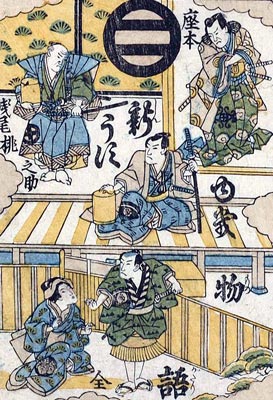| SHIN USUYUKI MONOGATARI |
| Play title | Shin Usuyuki Monogatari |
|||||||||||||||||||||||||||||||||||||
| Authors | Matsuda Bunk˘d˘ Miyoshi Sh˘raku Takeda Koizumo I (Takeda Izumo II) Ogawa Hanbei |
|||||||||||||||||||||||||||||||||||||
| History |
The play "Shin Usuyuki Monogatari" was originally written for the puppet theater (Bunraku) and staged for the first time in the 5th lunar month of 1741 in ďsaka at the Takemotoza. It was adapted for Kabuki a few months later and staged for the first time in the 8th lunar month of 1741 in Ky˘to at Hayagumo Ch˘dayű's theater, produced by Sakakiyama Jűtar˘ I [casting]. |
|||||||||||||||||||||||||||||||||||||
| Structure |
"Shin Usuyuki Monogatari" was originally a 3-part drama. The current version is now made up of 4 acts (divided into 7 scenes). Act I, Act II, Act III and Act IV are commonky called "Hanami" (Cherry Blossom Viewing), "Sengi" (Inquiry), "Sannin Warai" (Three Laughs) and "Kajiya" (The Forge). A standard t˘shi ky˘gen production of "Shin Usuyuki Monogatari" is made up of "Hanami", "Sengi" and "Sannin Warai". A full-length production includes "Kajiya" but it is quite a rare event as the 4 latest full-length staging occurred in May 1948 (T˘ky˘ Gekij˘), January 1957 (Shinbashi Enbuj˘), September 1967 (Kabukiza) and November 2002 (Kabukiza). |
|||||||||||||||||||||||||||||||||||||
|
||||||||||||||||||||||||||||||||||||||
| Key words |
Gidayű Ky˘gen Giri/Ninj˘ Hanami Jidaimono Sengi Tachimawari |
|||||||||||||||||||||||||||||||||||||
| Summary |
Saemon, the eldest son of the Sonobe family and Princesss Usuyuki, the daughter of the Saizaki family, fall in love after glimpsing one another under the cherry blossoms of Kiyomizu temple and are brought together by their servants. The villain Daizen places a curse on a sword presented to the temple by Saemon. By framing the couple, he hopes to bring destroy their families so they cannot hinder his effort to take over the country. Saemon's servant Tsumahei almost defeats this plan and is attacked by Daizen's henchmen in a spectacular fight scene with water buckets. Saemon and Princess Usuyuki are charged with treason. Minbu comes to investigate the two, and although they maintain their innocence, Daizen is able to turn the evidence against them. The compassionate Minbu gives them a temporary reprieve, but still, must place them under house arrest, each at the house of the other's family, with Saemon at the Saizaki residence and Princess Usuyuki at the Sonobe residence. Unable to prove the innocence of the young couple, their fathers are charged with cutting off their heads. Sonobe Hy˘e and his wife Ume-no-Kata allow Princess Usuyuki to escape. Saizaki appears with a head box which he says contains the head of Saemon and demands that Sonobe cut off Princess Usuyuki's head. Sonobe returns, having secretly stabbed himself to atone for letting Princess Usuyuki escape. Saizaki reveals that, in fact, he has done the same and the two, seemingly stern and villainous men reveal that they have sacrificed themselves for love of their children. Dankur˘, the villainous son of the swordsmith Masamune longs to master the secrets of sword-making, but his father refuses to teach anything, nor will he teach anything to his apprentice Kunitoshi, the son of Kuniyuki. But with many plot twists, this epic play comes to a conclusion in a melding together of young love, the transmission of ancient secrets of sword-making and finally, an old sword-maker finding an opportunity to return a debt to his teacher, the man that taught him everything he knows. Source: Earphone Guide website |
|||||||||||||||||||||||||||||||||||||
 |
 |
|
The actors Nakamura Noshio II (middle/left), Yoshizawa Iroha I (bottom/left) and Asao Tamejűr˘ I (top/right) playing the roles of Princess Usuyuki, Sonobe Saemon and the evil Dankur˘ in the drama "Shin Usuyuki Monotagari", which was staged in the 11th lunar month of 1790 at the Kado no Shibai |
The cover of the illustrated playbill of "Shin Usuyuki Monogatari" for the 11th lunar month of 1830 production at the Chikugo no Shibai |
|
|
| Contact | Main | Top | Updates | Actors | Plays | Playwrights | Programs | Links | FAQ | Glossary | Chronology | Illustrations | Prints | Characters | Derivatives | Theaters | Coming soon | News |